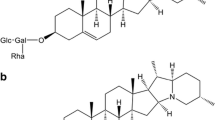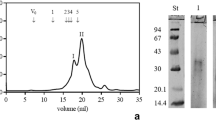Abstract
Glycoalkaloids in potato-derived products result in bitter taste and potentially toxic effects at high intakes. Generally, extraction of glycoalkaloids prior to HPLC analysis is carried out by dilute acetic acid. For most potato-derived extracts including heat-coagulated potato proteins, this extraction method is sufficient to achieve satisfying tri-glycoalkaloid (TGA) recoveries. Soluble potato proteins obtained by non-denaturing processes show different requirements for glycoalkaloid extraction. TGA extraction was optimized for two commercially available native potato protein isolates and compared to heat-coagulated potato protein. The highest TGA levels were determined in the extract when extraction was carried out at 40 °C by at least 5 % acetic or propionic acid supplemented with 20 mM Na-1-heptanesulfonate (HSA). Addition of HSA results in substantially improved TGA extraction and induces precipitation of soluble protein which enhanced sample cleanup. On the contrary, extraction of TGA from coagulated potato protein in the presence of HSA showed a reduced TGA extraction efficiency. This improved TGA extraction procedure for soluble non-denatured potato protein isolates results in reliable quantification of bitter tasting and toxic glycoalkaloid levels. This contributes to a non-bitter and safe use of the nutritional and functional benefits of this plant protein in food applications.



Similar content being viewed by others
Abbreviations
- TGA:
-
Tri-glycoalkaloid
- HSA:
-
Na-1-heptanesulfonate
- PJ:
-
Potato juice
- HMW:
-
High molecular weight potato protein isolate
- LMW:
-
Low molecular weight potato protein isolate
- kDa:
-
Kilodalton
- SPE:
-
Solid-phase extraction
- HCl:
-
Hydrochloric acid
- HAc:
-
Acetic acid
- PPA:
-
Propionic acid
- mM:
-
Millimolar
References
Alt V, Steinhof R, Lotz M, et al. (2005) Optimization of glycoalkaloid analysis for use in industrial potato fruit juice downstreaming. Eng Life Sci 5:562–567
Alting AC, Pouvreau L, Giuseppin MLF, van Nieuwenhuijzen NH (2011) Potato proteins. In: Phillips GO, Williams PA (eds) Handbook of food proteins, first. Woodhead Publishing Ltd., Cambridge, pp. 316–334
AOAC official method 997.13 (2000) Glycoalkaloids (α-Solanine and α-Chaconine) in potato tubers. In: AOAC official methods of analysis. Chapter 49 Natural Toxins, pp 62–64
Bárta J, Heřmanová V, Diviš J (2008) Effect of low-molecular additives on precipitation of potato fruit juice proteins under different temperature regimes. J Food Process Eng 31:533–547
Bártová V, Bárta J (2009) Chemical composition and nutritional value of protein concentrates isolated from potato (Solanum tuberosum L.) fruit juice by precipitation with ethanol or ferric chloride. J Agric Food Chem 57:9028–9034
Boisen S (1999) Determination of the digestibility and biological value of two potato protein concentrates. Tjele, Denmark
Driedger DR, Sporns P (1999) Glycoalkaloid concentration in by-products of potato starch extraction as measured by matrix-assisted laser desorptionionization mass spectrometry. J Food Process Preserv 23:377–390
Friedman M (2004) Analysis of biologically active compounds in potatoes (Solanum tuberosum), tomatoes (Lycopersicon esculentum), and jimson weed (Datura stramonium) seeds. J Chromatogr A 1054:143–155
Friedman M (2006) Potato glycoalkaloids and metabolites: roles in the plant and in the diet. J Agric Food Chem 54:8655–8681
Friedman M, McDonald GM, Filadelfi-Keszi PM (1997) Potato glycoalkaloids: chemistry, analysis, safety, and plant physiology. CRC Crit Rev Plant Sci 16:55–132
Gonzalez JM, Lindamood JB, Desai N (1991) Recovery of protein from potato plant waste effluents by complexation with carboxymethylcellulose. Food Hydrocoll 4:355–363
Graf A-M, Steinhof R, Lotz M, et al. (2009) Downstream-processing mit Membranadsorbern zur isolierung nativer proteinfraktionen aus kartoffelfruchtwasser. Chemie Ing Tech 81:267–274
GRAS notice 447 (2012) GRAS Exemption claim for potato protein isolates. U.S. Food and Drug Administration
Houben RJ, Brunt K (1994) Determination of glycoalkaloids in potato tubers by reversed-phase high-performance liquid chromatography. J Chromatogr A 661:169–174
Knorr D (1977) Protein recovery from waste effluents of potato processing plants. Int J Food Sci Technol 12:563–580
Knorr D (1982) Effects of recovery methods on the functionality of protein concentrates from food processing wastes. J Food Process Eng 5:215–230
Knuthsen P, Jensen U, Schmidt B, Larsen IK (2009) Glycoalkaloids in potatoes: content of glycoalkaloids in potatoes for consumption. J Food Compos Anal 22:577–581
Lindner P, Ben-Gera I, Keren R (1981) Precipitation of proteins from potato juice with bentonite. J Sci Food Agric 32:1177–1182
Lisinska G, Leszczynski W (1989) Potato science and technology. In: Lisinska G, Leszczynski W (eds) Potato science and technology. Elsevier applied science publishers Ltd., London, New York, pp. 11–43
Liu Z, Wu Z, Li R, Fan X (2013) Two-stage foam separation technology for recovering potato protein from potato processing wastewater using the column with the spiral internal component. J Food Eng 114:192–198
Løkra S, Schüller RB, Egelandsdal B, et al. (2009) Comparison of composition, enzyme activity and selected functional properties of potato proteins isolated from potato juice with two different expanded bed resins. LWT - Food Sci Technol 42:906–913
Morris SC, Lee TH (1984) The toxicity and teratogenicity of Solanaceae glycoalkaloids, particularly those of the potato (Solanum tuberosum): a review. Food Technol Aust 36:118–124
Nestares T, Lopez-Jurado M, Sanz A, Lopez-Frias M (1993) Nutritional assessment of two vegetable protein concentrates in growing rats. J Agric Food Chem 41:1282–1286
Ralla K, Sohling U, Suck K, et al. (2012) Separation of patatins and protease inhibitors from potato fruit juice with clay minerals as cation exchangers. J Sep Sci 35:1596–1602
Starch Europe (2014) EU starch market figures. The European Starch Industry Association. http://www.starch.eu/european-starch-industry/. Accessed 13 Oct 2015
Strætkvern KO, Schwarz JG (2012) Recovery of native potato protein comparing expanded bed adsorption and ultrafiltration. Food Bioprocess Technol 5:1939–1949
Strætkvern KO, Schwarz JG, Wiesenborn DP, et al. (1999) Expanded bed adsorption for recovery of patatin from crude potato juice. Bioseparation 7:333–345
Van Gelder WMJ, Vonk CR (1980) Amino acid composition of coagulable protein from tubers of 34 potato varieties and its relationship with protein content. Potato Res 23:427–434
van Koningsveld GA, Gruppen H, de Jongh HH, et al. (2002) The solubility of potato proteins from industrial potato fruit juice as influenced by pH and various additives. J Sci Food Agric 82:134–142
Vikelouda M, Kiosseoglou V (2004) The use of carboxymethylcellulose to recover potato proteins and control their functional properties. Food Hydrocoll 18:21–27
Wolf MJ, Duggar BM (1946) Estimation and physiological role of solanine in the potato. J Agric Res 73:1–32
Zwijnenberg HJ, Kemperman AJB, Boerrigter ME, et al. (2002) Native protein recovery from potato fruit juice by ultrafiltration. Desalination 144:331–334
Acknowledgments
The authors wish to thank Paul Mijland for carrying out the one-way ANOVA analysis and Joan Schipper for assistance with the TGA analysis.
Author information
Authors and Affiliations
Corresponding author
Ethics declarations
Conflict of Interest
Marc C. Laus declares that he has no conflict of interest. Gert Klip declares that he has no conflict of interest. Marco L. F. Giuseppin declares that he has no conflict of interest.
Ethical Approval
This article does not contain any studies with human participants or animals performed by any of the authors.
Informed Consent
Not applicable.
Rights and permissions
About this article
Cite this article
Laus, M.C., Klip, G. & Giuseppin, M.L.F. Improved Extraction and Sample Cleanup of Tri-glycoalkaloids α-Solanine and α-Chaconine in Non-denatured Potato Protein Isolates. Food Anal. Methods 10, 845–853 (2017). https://doi.org/10.1007/s12161-016-0631-2
Received:
Accepted:
Published:
Issue Date:
DOI: https://doi.org/10.1007/s12161-016-0631-2




